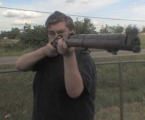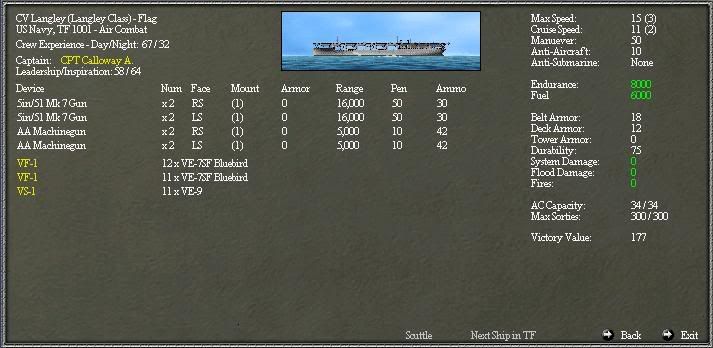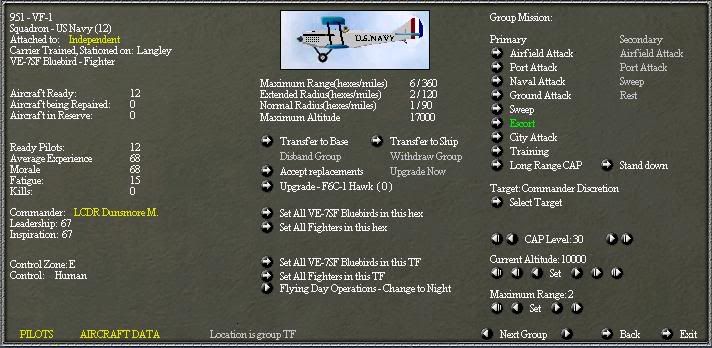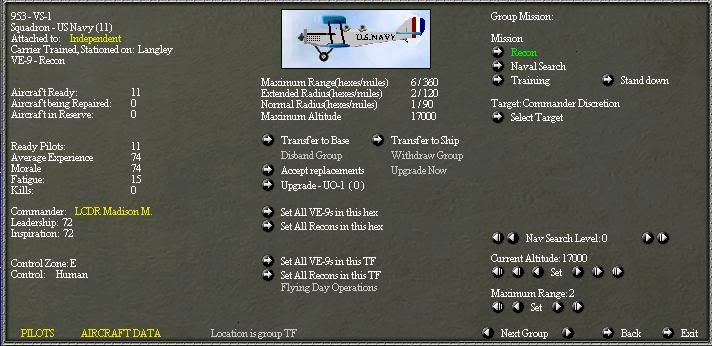
Vought VE-7SF Bluebird.
The Vought VE-7 Bluebird was originally designed as a 2 seat advanced training aircraft, first flown on February 11, 1918. It never did replace the Curtiss JN-4 Jenny, but oddly enough was quite a remarkable aircraft. In the hands of an experienced pilot, the VE-7 could outmaneuver a Nieuport 28, SPAD XIII, and an SE-5a, giving it great potential to be converted to a fighter. However, since the army needed planes desperately at the front, it was decided that American Aero Squadrons would remain using European designed fighters. The Navy, which had also ordered some 60 planes, did modify the plane as a fighter. By removing the rear cockpit, and mounting 2 Vickers .303 machine guns, the navy had a very capable fighter, one that could hold its own against the planes that were building in Europe. By the commissioning of the Langley in 1922 the .303 Vickers had been replaced by American made Brownings, and the new plane, designated the VE-7SF, made the first flight off the Langley on October 17, 1922. The Fighter would serve on until 1925, when the Curtis F6C Hawk began replacing it.

Vought VE-9.

Vought VE-9H.
The Vought VE-9 was a development of the VE-7. Used as an observation aircraft, it proved immediately succesful in all branches of service. 2 models are available in War Plan Orange, the VE-9 and the VE-9H. The VE-9 is the standard arrestor hook and fixed landing gear version, deployed on the USS Langley. It has no armament but will be invaluable in scouting roles. The VE-9H is the seaplane variant. The VE-9 is deployed on some of the newer US battleships (Tennessee's and Colorados), and is the first scout plane that the US will receive.

Vought UO-1.

Vought UO-1 Floatplane Variant.
The Vought UO-1 is the first purpose built observation plane the USN receives (the previous VE-9 was designed as a trainer/observation plane). It is first assigned starting in 1923, going in service aboard the USS Richmond. Starting in March 1923, as the WWI US dreadnoughts receive catapaults, UO-1 squadrons will begin appearing to outfit them. In addition, UO-1s with landing gear will begin to replace the VE-9s flying off the Langley. Also, unlike the VE-9s, the UO-1 is capable of carrying a small bomb load, making the carrier based version the first carrier based light bomber available.

Vought FU-1 Battleship Fighter.
The Vought FU-1 is an offshoot of the UO series appearing in 1926, and its original designation was UO-3. Essentially a single seat UO-1 (for gameplay purposes it uses the same graphic as the UO-1 float plane), it was armed with 2 forward firing .30 Browning machine guns. The premise was to allow battleships to have some sort of fighter protection, in view of the fact that the majority of the time the Langley could not keep pace with the battle line (The Langley had a speed of 15 knots, vs the battlelines 21). US ships will receive the UO-1 scout, but several battleships can receive the FU-1 "battleship fighter". A special note should be given here. With the commissioning of the Lexington and Saratoga in 1928, the navy saw no further need for a "Battleship fighter" and the project was dropped. Given that the Lady Lex and Sara will not be present as carriers, the player can choose to leave these Fighter groups as is, or replace them with UO-1 or O2U scouts. Groups of UO-1s will be created for each BB that will/can receive a catapault. However, 5 or 6 Battleship Fighter squadrons will also be created. If the player wishes to assign one of these units to a ship the ship's UO-1 squadron will have to be reassigned. If the players decides to stop using the FUs, then the 2 squadrons can be switched.

Vought O2U-1 Corsair.

Vought O2U-1 Corsair float plane variant.
The Vought O2U is the final observation plane the US receives in the game. Arriving in early 1928, this plane will set the standard for US scout planes of the future. Mounting 1 Forward firing .30 Browning, 1 or 2 rear firing Lewis guns, and a 500 pound bomb load, this is one of the most versatile planes designed by Vought. The carrier/land based version can also be used as a very versatile scout bomber (In real life, in 1928 USMC O2U corsairs became the first plane to launch an unsupported attack on a fortified position, and during this attack againt Nicaraguan rebels, Lt. Frank Shilt was awarded the Medal of Honor). The UO-1s on the Battleships will upgrade to this plane, and with it can make light attacks on enemy shipping, in addition to recon duties. Used with the FU-1 Battleship Fighter, this gives American battleships a slight edge over their Japanese counter parts.

Curtiss F6C-1 Hawk.

Curtiss F6C-4 Hawk.
The Curtiss F6C Hawk, which is a navalized P-1 Hawk, begins to arrive in late 1925. A superb fighter, this plane will have 2 variants. The F6C-1 powered by an inline engine, and the F6C-4 powered by a radial engine. The P-1 army fighter (also included) begins delivery in mid 1925, followed by this navalized version. This fighter has a top speed of 159 mph, 42 mph more than the VE-7 it replaces. In addition, it is vastly superior to the Mitsubishi 1MF1 fighter used on Japanese carriers. Like the VE-7, it can carry a 100lb bomb under each wing.

Boeing F4B-1.
The Boeing F4B begins deliveries at the very end of the second campaign scenario. The ultimate in the 1920's US carrier fighter, the plane is fast, maneuverable and well armed. Range is good, and so is versatility. With a max speed of 175mph, the fighter retained the 2 .30 cal Brownings of the early fighters. However, the fighter had an increased bombload, capable of 1 100lb bombs under each wing, and a 500lb bomb or a 41 gallon drop tank under the fuselage. Only the F4B-1 model will be represented, as the F4B-2 didn't enter service until late 1930. The F4B enters service rouglt the same time as the Japanese A1N carrier fighter. However, the Japanese fighter is almost 40 mph slower. Both carry the same number of machineguns.
The Martin T3M attack plane begins arriving in mid 1926, just after the first F6Cs. A dedicated attack plane, it is the only USN plane capable fo air dropping a torpedo. carring a crew of three, the bomber has one of the longest reaches of any USN plane of 1926. In late 1927, the T3M is supplanted by the upengined T4M. While faster, the T4M is also much shorter legged than its predecessor.
The US airgroups of War Plan Orange will be a little bit different than what you are used to in War in the Pacific. In the 1922-1926 scenario (1 carrier). Starting out, the Langley will have 3 groups, VF-1, VF-1A and VS-1. VF-1 consists of 12 VE-7SFs, VF-1A of 11 VE-7SFs, and VS-1 of 11 VE-9s. This is done, so that when the T3Ms and T4Ms become available, the player can remove either VF-1A or VS-1, and replace it with the new T3M group. This is done to 1) give the player a choice of how to compose his CVAGs, and 2) reflect the non-standardization of US aircraft in the 1920's.
USN upgrade paths.
USN Fighter Squadrons:
Ve-7SF ->F6C-1 -> F6C-4 ->F4B
USN Carrier Scouts Sqdrns:
VE-9 ->UO-1 ->O2U
USN Attack Sqdrns
T3M->T4M
USN Shipboard Scout Sqdrns:
VE-9H -> UO-1 -> O2U Float
USN Battleship Fighter Sqdrns:
FU-1
The final plane list:
US Aircraft for the War Plan Orange Mod
Vought VE-7SF Carrier Fighter (1923-1928)
Vought VE-9 Carrier Scout Plane (1922-1928)
Vought VE-9H Shipboard Scout (1922-1924)
Curtiss F6C-1 Hawk Carrier Fighter (1926-1928)
Curtiss F6C-4 Hawk Carrier Fighter (1928-1930)
Boeing F4B-1 Seahawk Carrier Fighter (1928-1930)
Martin T3M Carrier Torpedo Bomber (1925-1927)
Martin T4M Carrier Torpedo Bomber (1927-1930)
Vought UO-1 Shipboard Scout plane (1923-1928)
Vought UO-1 Carrier bases scout/bomber plane (1923-1928)
Vought FU-1 (UO-3) Battleship fighter seaplane (1926-1930)
Vought 02U Corsair Carrier Scout Plane (1928-1930)
Vought 02U Corsair (Float) Shipboard Scout Plane (1928-1930)
Naval Aircraft Factory PN-10 Flying Boat (1925-1930)
Curtiss P-1 Hawk Landbased Fighter (1924-1930)
Curtiss A-3 Falcon Landbased Bomber
DeHavilland DH-4B Landbased Fighter/bomber
British Airplanes
Sopwith Camel (Land and Carrier based Fighter)
Sopwith Snipe (Land Based Fighter)
Dehavilland DH-4B Landbased Bomber (British markings)
Sopwith Cuckoo (Carrier Based Torpedo Bomber)
Fairey III (Shipboard Scout Plane)
Dehavilland DH-4 Landbased Fighter
Gloster Grebe Landbased Fighter
Japanese Airplanes
Mitsubishi 1MF2 Carrier Based Fighter
Mitsubishi 1MF4 Carrier Based Fighter
Nakajima A1N1 Carrier Based Fighter
Mitsubishi 2MR1 Carrier Based Scout Plane
Mitsubishi B1M1 Carrier Based Bomber
Mitsubishi B1M2 Carrier Based Bomber
Yokosuka E1Y Shipboard Seaplane
Kawasaki KDA-2 Landbased FIghter
Not that I decided not to include flying off platforms in the game. This would result in gamey results, and in about 6-10 months after the start date all US major dreadnoughts will have float planes (NOTE: The Deleware, Florida, Wyoming, and New York class dreadnoughts don't receive catapaults until 1926).
A new feature: Carrier conversions!
To make up for Japan and the US not getting carriers converted from battleships, the Japanese Kurama class predreadnoughts and the US Charlotte class armord cruisers can be converted to carriers. However, here is how it works.
Conversion is a 9 month process. This is accomplished by a series of refits.
In 1926, both ships classes undergo a last refit as OBBs or ACRs. In January 1927 (the next refit) the ships begin conversion to a carrier. In this refit, all armor is removed, all guns deleted, and speed, range, andendurance set to 1. This prevents the player from using the the ship. In March, May, and July the ship undergoes other refits which do absolutley nothing, but forces the player to keep the ship in dock for some time, if he decides to convert in 1928. In August, The ship undergoes 1 final refit, and emerges as a fully functioning carrier with a capacity of around 22. While they will retain their belt armour they had as a OBB or ACR, their deck armor will be fairly weak. Now, there are penalties to doing this.
1) The ship is out of action for a period of around 9 months. Unlike regular Witp, you don't have 1 refit and then sail the ship into harms way. If you need everything that will float for a battle, this will hurt you.
2) While totalling carriers completed and potential refits, each side can have no more than 4 carriers. However, there will be enough airgroups to equip 3, and enough planes to run 2 at a time. So, if you actually do build the extra CVs, you might not have planes to use them.
3) Use of ships involved. Japan has only second rate armoured cruisers, and needs to use her pre dreadnoughts in that role. The 2 Kuramas are Japanese best pre dreadnoughts, and loosing them could cause the Japanese problems. The US has a good collection of powerful armoured cruisers. However, with most of her predreadnoughts more obsolete than her Japanese counter parts, she needs her ACRs to fill the void. In addition, ACRs are invaluable in the commerce raiding role, and loosing 3 could seriously hamper US offensive operations.
I have done this because I want to impress upon players that Naval doctrine is determined by the dreadnought, not the carrier. If you try and use a lot of carriers, you will only wind up hurting yourself.
Tonight or tomorrow, I'll post soem more screenshots. Also, I have been doing a lot of talking with Matrix about the mod, and I am getting some very good help and cooperation from them, all of which is going to improve the mod. So, lots of changes are happening behind the scenes, but this is turning out to be the largest mod for War in the Pacific, and hopefully the most successful. So stay tuned!
for those who don't know:
The War Plan Orange mod is a totally new modification for WiTP. It includes new graphics, ships, and aircraft. It is designed to simulate what-if naval battles of the 1920's. Being what-if, the Washington Treaty of 1922 is not ratified, and so WWI ships and never were designs clash in battleship slugfests. Carrier aviation is in its infancy, with fraile, short legged biplanes. Amphibious invasions too are in their infancy. Warfare will be quite different than WW2, and yet different from WWI aswell. First getting the idea in July (while playing WiTP), this mod was started back in August. Since then, it has taken on a life of its own. Battleship fights, commerce raiding, early carrier and submarine warfare are all included. It is a different experience, but a rewarding one to see lines of battlewagons with guns blazing.





















